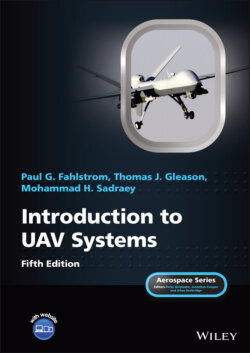Читать книгу Introduction to UAV Systems - Mohammad H. Sadraey - Страница 80
3.13 Aerodynamic Efficiency
ОглавлениеOne of the important parameters in a cruising flight is the aerodynamic efficiency. This parameter is directly a function of the aircraft lift‐to‐drag ratio. One of the objectives in aerodynamic design of an air vehicle is to produce the maximum lift with a minimum drag. The aerodynamic efficiency of an air vehicle relies heavily on the section of its wing/tail; that is “airfoil.”
Using the equations for lift and drag, one can readily prove the following relation for the maximum lift‐to‐drag ratio:
(3.15)
The lift versus drag curve is further discussed in Section 3.5. Reference [12] has derived the following expression for the maximum lift‐to‐drag coefficients ratio:
(3.16)
With this relationship, one is able to evaluate the maximum lift‐to‐drag ratio of any aircraft. The only necessary information is the aircraft zero lift drag coefficient (CDo) and the induced drag correction factor (K). Graphically, the maximum L/D corresponds to the slope of the tangent to the CD‐CL figure (drag polar), which is shown in Figures 3.7 and 3.13. Figure 3.7 shows the two‐dimensional drag coefficient (Cd) and the moment coefficient as a function of the lift coefficient (Cl) for the NACA 23021 airfoil.
Aerodynamic efficiency (ηE) is defined as the ratio of the difference between lift and drag over the lift:
(3.17)
In a cruising flight, lift is equal to the aircraft weight (L = W). Thus,
(3.18)
The maximum aerodynamic efficiency is
(3.19)
Equations (3.19) and (3.16) reveal that the following factors play an important role in air vehicle aerodynamic efficiency: (1) aircraft zero lift drag coefficient (CDo) and (2) induced drag correction factor (K). Furthermore, due to Equation (3.6), the Oswald span efficiency factor (e) and the wing aspect ratio (AR) are also impacting the aerodynamic efficiency.
As a conclusion, in order to increase the air vehicle maximum aerodynamic efficiency, one must: (1) decrease the aircraft zero lift drag coefficient and (2) increase the wing aspect ratio. High aspect ratio wings (long and slender) are conducive to good range and endurance. Short stubby (low AR) wings generate low aerodynamic efficiency (i.e., penalize the length of time‐on‐target during reconnaissance missions), but are good for highly maneuverable fighters.
The wing aspect ratio for the MALE UAV General Atomics MQ‐1 Predator (see Figure 11.1) wing is about 22.5, while for the HALE UAV Northrop Grumman RQ‐4 Global Hawk (see Figure 1.4) wing is about 25. The wing aspect ratio for the small UAV AeroVironment RQ‐11 Raven (see Figure 18.11) is 3.7.
